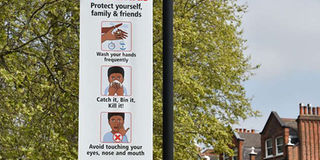China virus? That is how stigma breeds

A banner displaying a coronavirus message hangs on a lamppost in west London on April 18, 2020, during the novel coronavirus pandemic. PHOTO | GLYN KIRK | AFP
What you need to know:
- Constant factual communication in a tone that doesn’t lecture or vilify people about Covid-19 is essential.
- Using language that doesn’t augment negative stereotypes, debunking myths on the disease while updating health care preparedness is of utmost importance.
According to the Centers for Disease Control, stigma occurs when people associate a distinct risk with a specific people, place, or a minority group and there is no evidence that the risk is greater in that group than in the general population.
In 1918 a virus estimated to have killed 20 to 50 million people worldwide was nicknamed “The Spanish Flu”. The nickname assumed that Spain was where the virus originated from but actually this was a result of gross misinformation.
From the moment Covid-19 was first discovered in Wuhan, China, the virus was immediately labelled “The Chinese Virus”.
That is how the language used during an outbreak sets the basis for stigma. The effects of stigma are deadly and costly, as seen from other viruses like HIV in the 1980s.
HIV lacked timely, accurate information which sparked fear that fuelled widespread stigma and discrimination. Those who contracted it were suppressed into silence as the stigma against the virus made it impossible to getting tested and accessing treatment and care.
Stigma not only makes people fear, discriminate or aggressively ostracise others, but it also regards institutions meant for the treatment of stigmatised diseases with prejudice.
For example in Kenya, Mathari Hospital — for patients with mental illnesses — is tainted as a “mad people’s” place. In Malaysia, Sungai Buloh Hospital, originally built in 1930 for leprosy patients, faced same prejudice.
The history of stigma and stigmatisation is especially common in disease outbreaks, meaning the stigma around Covid-19 should begin to worry us.
As cases rise in Kenya, the insidious stigma will rise too. And then natural reflex actions like sneezing and coughing can become physically life-threatening when they happen in public due to being known symptoms of Covid-19.
FACTUAL INFORMATION
In order to counter this, we must learn from past mistakes in dealing with disease outbreak stigmas. Constant factual communication in a tone that doesn’t lecture or vilify people about Covid-19 is essential.
As much as many people have died from it, many others have survived, so it is not a death sentence as it currently feels or seems.
Using language that doesn’t augment negative stereotypes, debunking myths on the disease while updating health care preparedness is of utmost importance.
Explaining whether one can be re-infected after being cured is also key in this scenario. Adjusting routines and behaviour without causing further discrimination on people is also a good way of reducing the fear that fuels stigma.
Everyone is afraid of this virus, and that’s a given, what we can’t do is let that fear be the reason we fall into stigma, because that will only prolong the collective recovery from all the effects of this novel virus.
Scheaffer Okore is a policy analyst; [email protected]





